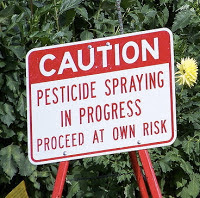Pesticide Content in Food Less Regulated by Codex Than Vitamins and Minerals
by Brandon Turbeville
In the past, I have written numerous articles dealing with Codex Alimentarius and its guidelines regarding vitamin and mineral food supplements, food irradiation, and genetically modified (GM) food. I have also written about the unfolding agenda to implement Codex standards on a global scale to the detriment of all those who value clean, healthy food and the ability to make their own choices regarding what they do or do not eat.
Keeping with the theme of previous reports, it is important to note the official Codex position on pesticide content in food and, specifically, Persistent Organic Pollutants (POPs).
Indeed, for those who are familiar with the aforementioned Codex standards, it may not come as a surprise that dangerous pesticides and persistent organic pollutants (POPs) largely escape the application of rigorous standards that vitamins and minerals receive.
Widget not in any sidebars
While it may be common knowledge to many, there are just as many who are unaware of the extent to which pesticide residues exist in the average unit of food. The fact is that virtually any and all pesticides used in food production eventually end up in the food itself, even in the animals that consume that food as feed. Logically, these pesticides end up in the systems of those that consume these plants and animals.
Even at this stage of scientific capabilities, the full extent to which these pesticides are damaging to humans is not fully known, at least at the level of the general public. However, for many of these chemicals there is clear research linking them to adverse health effects, while for others the status is less clear, largely due to lack of compiled data.
At the very least, it is safe to say that these pesticides are not healthy and are potentially hazardous to human health. Yet, due to the large amount of pesticides in existence, the detailed testing of all these individual substances has never been conducted. The scientific research that does exist, however, is clear that pesticides do cause adverse effects in humans.
 For the purpose of this discussion we will distinguish between two types of pesticides: general pesticides and persistent organic pollutants (POPs). General pesticides are essentially any pesticides not considered a POP by the Stockholm Convention.[1] As the Stockholm Convention, as well as most national governments, banned the use of POPs, general pesticides are the most widely used throughout the world. Many of these substances have been linked to neurological problems, cancer, and Parkinson’s disease.
For the purpose of this discussion we will distinguish between two types of pesticides: general pesticides and persistent organic pollutants (POPs). General pesticides are essentially any pesticides not considered a POP by the Stockholm Convention.[1] As the Stockholm Convention, as well as most national governments, banned the use of POPs, general pesticides are the most widely used throughout the world. Many of these substances have been linked to neurological problems, cancer, and Parkinson’s disease.
Chlorpyrifos, a general pesticide, serves as a perfect example of the harmful effects of such chemicals. For years, it was one of the most widely used insecticides in both the United States and the world. Millions of pounds of the chemical were used in houses, schools, daycares, and public housing facilities exposing the occupants, children in particular, to the toxin. The insecticide is a known neurotoxin and cause of developmental disorders which is the main reason that the EPA, after years of exposure, finally announced it was ready to ban the chemical.
Before it was banned, however, Dow Chemical Co. “voluntarily” removed the product from the home market. Yet, although chlorpyrifos was removed from the home market, the agricultural uses continued with the tacit approval of the EPA.
It is interesting to note that insecticide use in agricultural products is regulated by the EPA. So the approval of chlorpyrifos as an agricultural pesticide by the FDA is in direct contradiction to its own stated policy.[2] This is because the EPA “acknowledged the special susceptibility and sensitivity of children to developmental and neurological effects from exposure to chlorpyrifos,” on its own website.[3]
If this is the case, then the ingestion of the chemical should also be viewed as dangerous. If simply being in the same house as chlorypifos can be harmful, then certainly its ingestion would be even more dangerous. Even if one were to claim that the proximity to the chemical were the main cause of the adverse effects associated with it, certainly they would not argue that touching or inhaling would be more dangerous than ingestion.
Yet this is apparently the position taken by the EPA because, elsewhere on their own website, they claim that children are at no risk from eating chlorypifos-treated food crops. Such statements set forth by the EPA are backed up with absolutely no evidence and there is no real agreement within the EPA as to how much of the chemical is too much.[4] This is merely one example of how the EPA is compromised when it comes to its regulatory duties and how agencies, when bedfellows with corporations, can speak publicly out of both sides of their mouth, all with no real consequence.
Yet chlorypifos is but one example. Many scientists have studied the effects of pesticides on human health and come to the conclusion that pesticide exposure results in adverse health effects.
Indeed, Parkinson’s disease is one of the most widely known risks associated with pesticide use. One such study was published in the Archives of Neurology and detailed a link between contact (not even ingestion) with pesticides and an increase in Parkinson’s disease. The study found that there was an increased risk for the disease in jobs related to construction and extraction, legal, and religious occupations.
 Interestingly enough, the same study also found that ever having worked in these fields as well as business and finance, transportation, or material moving was associated with a subtype of Parkinson’s’ characterized by gait disturbances and postural instability. The study also reported that agricultural, education, and health care workers did not see an overall increase in risk for Parkinson’s. However, only eight types of pesticides were studied in this regard so, logically, the amount of exposure to these particular chemicals would vary depending on the individual’s lifestyle and occupation.[5]
Interestingly enough, the same study also found that ever having worked in these fields as well as business and finance, transportation, or material moving was associated with a subtype of Parkinson’s’ characterized by gait disturbances and postural instability. The study also reported that agricultural, education, and health care workers did not see an overall increase in risk for Parkinson’s. However, only eight types of pesticides were studied in this regard so, logically, the amount of exposure to these particular chemicals would vary depending on the individual’s lifestyle and occupation.[5]
Thus, the authors state,
Other pesticide exposures such as hobby gardening, residential exposure, wearing treated garments or dietary intake were not assessed. Because these exposures may affect many more subjects, future attention is warranted.”[6]
However, the overall conclusion was that “The association of disease risk with pesticides support a toxicant-induced cause of parkinsonism.[7]
Clearly, after having established a link between pesticides and Parkinson’s and regardless of the intuitive or counterintuitive elements of the specific fields of employment most affected, the researchers have demonstrated the need for further investigation in regards to the effects of pesticides on the brain and other general health concerns. This link, of course, is all the more disturbing considering the obvious disinterest by which it is approached by the EPA.
In addition, the reader should keep in mind that this study only dealt with a small number of pesticides and one disease. Considering the enormous amount of pesticides being used during food production, the numerous different types of potential adverse effects, and long-term intake effects, these findings are only one small part of the tip of the iceberg of potential pesticide dangers.
Indeed, the knowledge that pesticides can cause Parkinson’s disease is already well known even without the aforementioned research. For years, researchers have regularly created Parkinson’s in lab animals by injecting them with pesticide chemicals. In fact, many of the diseases created in lab animals for research are created by injecting them with common pesticides and chemicals. This is quite interesting considering the claim made by many medical “professionals” that the cause of Parkinson’s is unknown.[8]
Evidently, the cause is only unknown when confronted with the damage to the profits of the pharmaceutical and chemical industry giants that would suffer if the cause (or at least one of them) turned out to be one or more of their profits.
Notes:
[1] These designations are only made in the context of this book and should not be taken as designations used for discussion outside of it.
[2] Schneider, Andrew. “Harmful pesticides found everyday food products.” Seattle Post Intelligencer. January 30, 2008. http://www.seattlepi.com/local/349263_pesticide30.html
[3] Ibid.
[4] Ibid.
[5] Baker, S.L. “On-the-job pesticide exposure is linked to Parkinson’s disease.” Naturalnews.com October 9, 2009. http://www.naturalnews.com/027202_Parkinsons_pesticides_disease.html
[6] Ibid.
[7] Tanner, CM, Ross GW, Jewell SA, Hauser RA, Jankovic J., Factor SA, Bressman S. Deligtisch A., Marras C, Lyons KE,Bhudhikanok GS, Roucoux DF, Meng C., Abbott RD, Langston JW. “Occupation and risk of parkinsonism: a multicenter case-control study.” Archives of Neurology. September 2009. 66(9): 1106-13. http://www.ncbi.nlm.nih.gov/pubmed/19752299 (link to abstract)
[8] Evans, Kim. “Pesticides Cause Parkinson’s Disease.” Naturalnews.com September 25, 2009.http://www.naturalnews.com/027098_pesticides_disease_Parkinsons.html
Brandon Turbeville is an author out of Florence, South Carolina. He has a Bachelor’s Degree from Francis Marion University and is the author of three books, Codex Alimentarius — The End of Health Freedom, 7 Real Conspiracies, and Five Sense Solutions and Dispatches From a Dissident. Turbeville has published over 200 articles dealing on a wide variety of subjects including health, economics, government corruption, and civil liberties. Brandon Turbeville’s podcast Truth on The Tracks can be found every Monday night 9 pm EST at UCYTV. He is available for radio and TV interviews.




